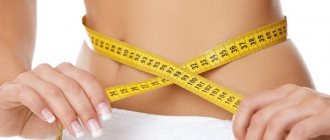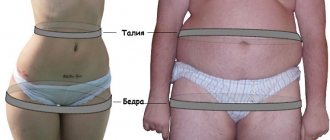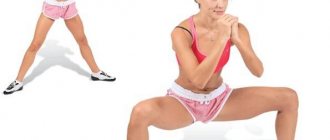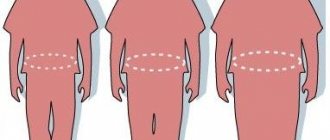No matter how hard you try to escape from reality, sooner or later you have to admit a sad fact: the years take their toll. The social status becomes higher, and with it, in direct proportion, the imprints of an incorrect lifestyle appear on the body: bags under the eyes, excess weight, hanging belly... And somehow it naturally turns out that the question of how to remove fat from the thighs is being discussed with men in the dressing room, while previously completely different topics ruled here. I would like to lose at least a couple of extra pounds, because it is difficult to fasten my shoes, and the zipper on my trousers offers stubborn resistance. And if the need for a lifestyle change has matured to its final stage, then you need to urgently take action: find out how to lose fat and put theory into practice.
Description
Essentially, fat legs are divided into two different categories depending on their causes. On the one hand, the legs become fat due to fat deposits, on the other hand, swelling of the legs can be caused by stagnation of fluids in the body. The latter is colloquially called “water in the feet.” Fat distribution disorders can also cause fluid collections to form in the tissue.
We can also talk about lipedema , a chronic disease with a violation of the distribution of fatty tissue under the skin, in which fat and water actively accumulate in the legs, buttocks and thighs. Hands can also be affected by this disease. Lipedema does not mean that a person eats too much or exercises too little. This is a progressive and incurable disease that causes severe discomfort. It is believed to be hereditary and hormones play a crucial role in its development.
You can suspect the presence of lipedema if you notice some of the signs listed above. The following signs should make a person wary:
- legs become fuller and fuller, despite dietary restrictions and an active lifestyle;
- legs react painfully to touch and pressure;
- even the slightest blow (for example, on the edge of a bed) is immediately accompanied by severe pain and large bruises;
- Swelling of the legs after prolonged standing or sitting;
- Cellulite;
- Painful lumps and knots under the skin.
- Often there is a feeling that the legs are filled with lead.
If these symptoms are detected, you should consult a phlebologist, lymphologist or angiologist to find out whether these signs are symptoms of existing lipedema.
Swollen and thick legs can have different causes, but in any case it is very important to consult a doctor promptly. Image: DenisProduction.com/stock.adobe.com
Symptom of swollen feet
The term “fat legs” simultaneously describes their main symptom. Although the location and distribution of swelling can vary greatly depending on the cause, it is common for thick legs to swell from the foot upward. Fluid collects between the connective tissue and skin, causing the limbs to become significantly larger in circumference. If the legs are elevated, the swelling often decreases or disappears on its own within a relatively short time.
Patients especially suffer from swollen legs after a full day of standing or sitting. Due to the monotonous load, blood accumulates in the veins of the legs and fluid in the connective tissues. If the legs are elevated and/or cooled, blood can flow back to the heart more easily and swelling thus stops.
However, fat legs can also take on a chronic form of the disease, meaning those affected suffer from swollen legs almost every evening or even during the day, often accompanied by the appearance of spider veins or varicose veins on them. In such cases, urgent therapeutic measures must be taken. Additionally, if your skin begins to discolor while pain begins, or only one leg becomes swollen, you should see a doctor immediately. Sudden acute swelling of the legs is especially critical. This requires timely medical examination.
In principle, the entire leg can swell (up to the thigh), but in most cases the swelling is limited to the area of the feet and ankles, to the maximum of the lower leg. The swelling may cause a feeling of tension in the legs and possibly slight numbness. The appearance of limited ability to move in this case is also not uncommon. Depending on the causes of its occurrence, swelling of the legs (fluid retention) in general can be expressed in extremely different forms. Thus, with the corresponding symptoms and various causes of thick legs, the doctor finds out in more detail the general picture of the disease.
Why do some men get fat in their thighs, legs and buttocks?
There are several options for the development of such events, for example:
- genetics;
- problems with hormones.
Genetics
Fat is usually stored where it is convenient for it. In men, this most often occurs in the abdomen and sides, but it can also occur in the thighs. It's all because of your genetics. Nature itself decides where your cookies and dumplings eaten before bed will go. It also depends on what genetics your ancestors had .
Perhaps you are a direct descendant of a centaur. That’s why you have such huge hips and such a toned torso (or not too toned, but at least not very fat).
But you can calm down a little, it’s not your fault, you can’t tell your body where and how much fat to store. Your only fault is that you were caught in random food relationships and ate your ass-blimp.
Problems with hormones
If it smells like a hormonal imbalance, then things are much worse. You could say that this glitch makes you a little bit of a woman. That is, you have problems in the balance of male and female hormones, androgens and estrogens.
You store fat according to the female type. And for women, such deposits are the norm, because they need massive thighs to bear children. But don’t panic too much, you’re unlikely to give birth to a baby, so you can relax your buns.
This hormonal imbalance is associated with your diet, bad habits, lifestyle, or taking any medications.
I advise you to go to the hospital with this question , because hormones are not to be trifled with. Today, female-type fat is deposited, and tomorrow you will start wearing women’s underwear. Joke. But go to the doctor anyway, and it’s better not to delay this issue.
But be that as it may, it was partly your disordered eating and sedentary lifestyle that led you to this appearance. I doubt that this article is being read by a person whose entire refrigerator is filled with vegetables and kefir. Most likely, my reader is a fan of eating dumplings with mayonnaise while watching a TV series.
Treatment methods for thick legs
Cosmetic procedures that will help get rid of fat legs:
- Anti-cellulite massage . It is painful, but helps solve the problem even at the initial stage of general weight loss. Additionally, gymnastics is prescribed, aimed at working the muscles of the lower extremities.
- LPG (lipo) massage . It is carried out with special rollers that act directly on the adipose tissue captured by the vacuum manipulator, destroying its cells. At the same time, it is possible to eliminate tissue swelling, destroy local fat deposits and cellulite, and also obtain excellent lifting and rejuvenation results. To achieve maximum results, 6 sessions are prescribed; if necessary, the course can be repeated after 1 month.
- Infrared sauna . Heat accelerates blood circulation and lymph flow, which leads to rapid cleansing of the body from waste and toxins. The result will be the absence of swelling, tightening of the skin and a decrease in the volume of the legs.
Foot wraps:
- Honey . For 2 tablespoons of bee honey add 1 teaspoon of cinnamon powder, ½ teaspoon of ground red pepper (can be replaced with mustard) and the same amount of lemon juice.
- With cosmetic clay . To lose weight, apply red, blue or black clay to your feet; the powder is first diluted with warm water to the consistency of thick sour cream.
- Chocolate . Dilute cocoa powder with milk or water in such a proportion that the resulting creamy mass is obtained.
Steam the skin of your feet well and dry with a hard towel. Apply the selected mask mixture to the surface. Wrap the lubricated legs with a special thin plastic cling film, and throw a warm light cloth over it to create a compression effect (towel, blanket). Such wraps are carried out for 20-30 minutes, 2 times a week.
Puberty
In childhood, both sexes have minimal differences in the volume of adipose tissue. However, during puberty, girls begin to accumulate fat, while boys develop muscle mass. Before the onset of menstruation, adipose tissue in girls' bodies should account for 15% to 20% of their body weight.
Low body fat percentage causes athletic girls who participate in gymnastics, dance or track and field to begin menstruating several years later than their peers who are less active. It is often necessary to reduce the amount of physical activity to allow fat tissue to form normally, which in turn activates hormonal balance and leads to the onset of regular menstrual cycles.
How to get rid of fat legs with exercises at home
You can remove fat legs at home with the right physical activity, which will be given to the lower limbs regularly, on a daily basis and in “dosed doses”.
Jumping for fat legs
Jumping works great against fatty legs, as it strengthens the muscles of the lower extremities, improves blood circulation in them and has a positive effect on the overall process of losing weight. Correction of the lower leg is done by jumping rope; you can start with 10-20 repetitions, gradually increasing the number. There are three jumping options that will help you lose weight in your legs:
- classic – with landing on both legs at the same time;
- against thick thighs - the jump is performed with each leg moving forward in turn;
- complicated - landing on one limb, then on the other.
The exercise is performed at a moderate pace; between cycles of 10-20 jumps you need to take a break, during which your arms and legs relax and your breathing is restored. The break time is no more than 1 minute.
Mahi
They help solve the problem of fat deposits in the thighs and buttocks, strengthen muscles and stretch them. Swings can be performed from a standing or lying position. In the first case, the legs are raised back and forth and to the sides, you can start with a minimum angle of elevation from the floor, then the height should be greater and greater.
From a lying position against thick legs apply:
- swings on the side - leaning on the hand, raise the leg up and forward, then turn and repeat everything for the other limb;
- swings on all fours - legs move up alternately.
Each exercise must be repeated at least 10 times, after which a break is taken for 30 seconds - stand up, shake your lower limbs, take several deep breaths and exhalations.
Squats for very thick legs and thighs
Squats will help you get rid of very thick legs and thighs. Beginners are recommended to perform standard, deep ones from a standing/shoulder-width position. There can be 5 repetitions, but every 1-2 days their number needs to be increased.
After strengthening the muscles, it is worth moving on to professional squats, when the knee joint is bent so that a right angle is formed between the lower leg and the thigh - it seems that the person is sitting. Half squats can first be performed with support, for which they use a chair, start with a minimum number of repetitions, the exercise is done at a slow pace with maximum muscle tension. You can make the exercise more difficult by doing a plie squat - heels together, toes apart, knees pointing in different directions.
Bike
A classic exercise that strengthens your thigh muscles. It is performed from a supine position - the legs are raised above the floor, bent at the knee joints and they are used to perform movements that imitate riding a bicycle.
Beginners can place their hands under their buttocks; subsequently, the upper limbs should be positioned along the body, and the pelvis should not be lifted off the floor. The time for performing the exercise is not limited.
Lunges to the side, with jumping
Stand straight, place your feet shoulder-width apart, place your hands on your waist. A step is taken to the side with the right leg, the body weight is transferred to this leg (it is slightly bent), the left leg is the supporting leg. Then the exercise is transferred to the other leg. Repeat 10-15 times, do 3 approaches with a break of 30-60 seconds.
You can make the exercise more difficult and put more stress on your legs, and speed up the burning of fat deposits with additional jumps - lunges are not done with a calm step to the side, but by jumping while changing legs.










